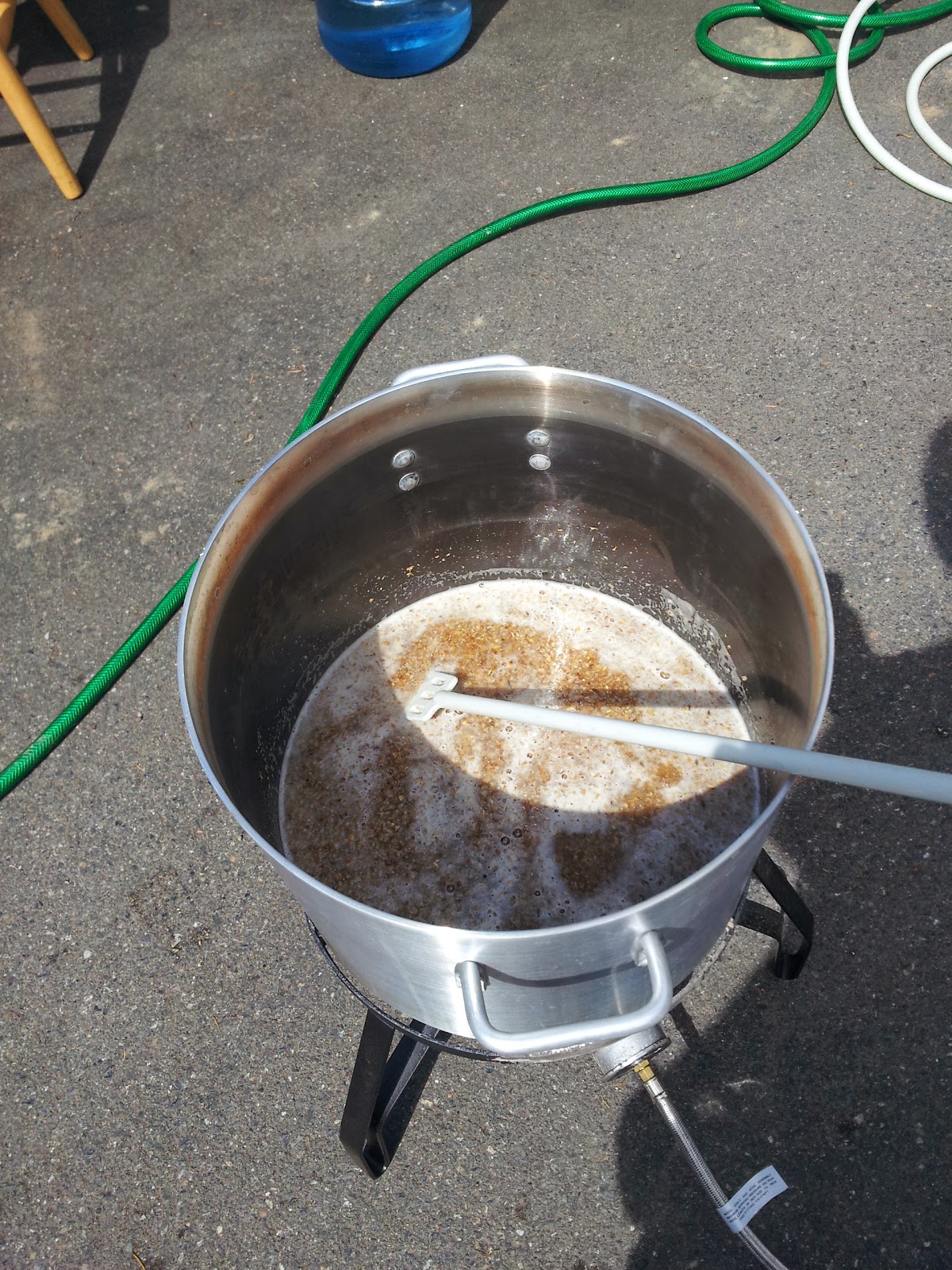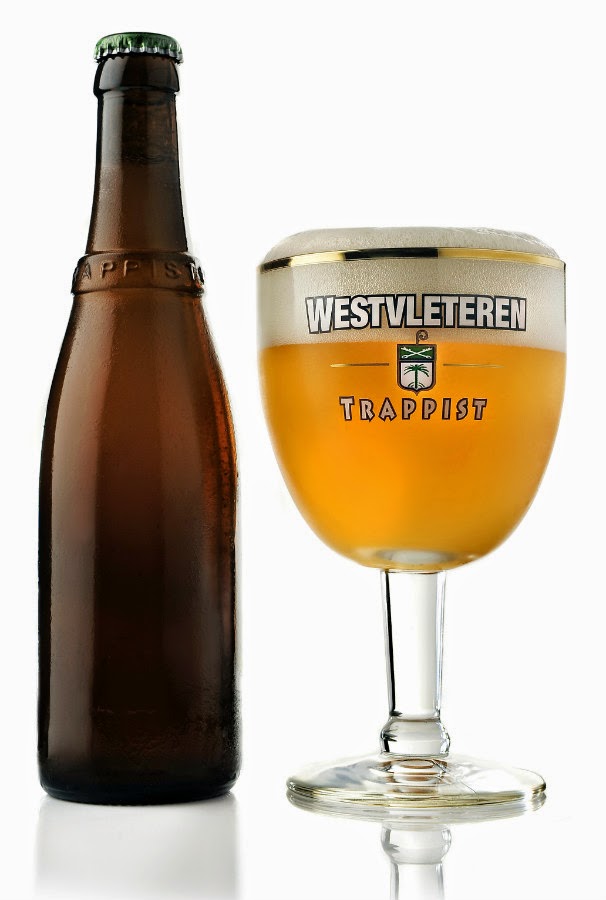I am extremely glad I decided to take a dry run with the
blonde in preparation for this beer because decoction mashes are tough. There was a lot going on with boiling water and grain everywhere, stretching the brewday from 6 to almost 9 hours even with friends there to help. I learned last time that the decoction calculations I got from my brewing software underestimated the required decoction volume. The temperatures were way low after the first decoction, and even further off after the second because I didn't adjust.
I use
BeerSmith for recipe formulation and mash calculations, but it clearly didn't handle the decoctions well. I don't know what formula it uses, but
on his blog, the BeerSmith himself posted the following formula as an example:
F = (TS – TI) / (TB – TI – X)
Where F is the fraction of the total mash, TS is the target step temperature, TI is the initial temperature, TB is the temperature of the boiling mash and X is an equipment dependent parameter (typically 18F or 10C).
This is a simplified formula replacing the specific heat of the mash tun, difference in specific heat between water and grain, and thickness of the decoction with the mysterious X term. It's "equipment dependent" meaning it needs to be dialed in through trial and error, which is what I'm trying to avoid with these calculations in the first place. I'm sure 18F is a good approximation for some systems, but its unclear at what scale.

Since I learned I'd be low on the last batch, I knew to increase my decoctions, but not by how much. I ended up rounding up to 2.6 gal, but I was still 10 degrees low, so I added a quick infusion of boiling water to bring it back on track. I upped the second decoction even more--from 1.25 gal to 2 gal--and that was much closer to the target.
After that, the boil went smoothly, with 120 minutes not only for increased boil-off and carmelization, but some time to keg the blonde and do a mini beer tasting. I think the
imperial stout convinced friends Jayce, Ryan, and Thomas to come out for the next brewday and learn to make some beer of their own, sweet!
Fermentation:

Instead of making a starter, I harvested Westmalle yeast from the last batch. I've read that most pro brewers believe their yeast performs best after a couple of generations (full fermentations, starter cultures don't count), so this should be an ideal situation for such a big beer. I ended up with .25 gal of yeast slurry, but only pitched a rough .05 gal as per the
Mr. Malty yeast calculator. Belgians tend to underpitch relative to American brewers in general, and this calculator in particular, so I would have been fine with a little less yeast, but with the high gravity wort and this strain's tendency to flock out early I decided not to risk it.
Wort cooled to 66F, 30 sec oxygen, temp set to 68F+.
2 Days: Temp raised to 78F.
11 Days: Temp set to 72F. Something went wrong here. I was out of town, but when my mom went to adjust it for me, it was only around 70F. I have no idea how hot it got during the more active phase of fermentation, but I'm hoping it got warm enough to attenuate fully before the yeast went to sleep. There was certainly some blowoff.

3 Weeks: Wracked a full 5 gal to secondary. This beer finished at 1.021. That is way high. Apparently the low temperatures did have a significant effect on the yeast since this was supposed to finish around 1.012. The gravity sample was sharply sweet, tasting almost like the dark candi syrup. However the warm feeling after swallowing is proof there was some fermentation going on. There's surprisingly no booziness at this point, so aging doesn't need to take care of that, but hopefully the yeast (I pulled a bit off the top of the yeast cake when I wracked) continue to nibble away at the remaining sugars. On a side note, it appears the top leaked during blowoff and dripped sweet residue down the sides of the carboy where some mold got ahold of it. I don't think anything could make its way into the fermenter (or would grow anyway with the low pH), but I'll have to keep an eye on it.
9/27/14 (~3 Months): I finally got around to bottling this beer. Since it's been so long since I brewed this beer, I made sure to repitch some wine yeast (EC-1118) with the priming sugar. When I went to measure the priming sugar, I couldn't find a calculator for aged beer; most calculate the residual carbonation for fresh beer based on the max temperature reached after the end of fermentation, but some of the carbonation will dissipate as the beer sits. In his post on
carbonating sour beers, Tonsmeire mentions that aged beer contains roughly .4 vol of residual CO2. Using the table
here, I estimated I would need about 7.25 oz of corn sugar to reach a target carbonation of 2.8 vol. I made sure to stir in the yeast and sugar as I bottled, but I'm not sure if much yeast made it into the bottles; there was still a lot of it on the bottom of the bottling bucket when I finished. The specific gravity of this beer hasn't changed, still 1.021, but it tastes a bit less sweet. There's a lot going on this beer, and I think it will be really good if the high carbonation lightens up the sweetness.
 ABV: 5.4%
ABV: 5.4% Here in the malt subtleties is where we find out what the oats brought to the beer. As I stated in the recipe post, oats are just bland. Raw flaked oats don't add any flavor--no maltiness, graininess, or nuttiness--leaving the beer tasting even lighter and simpler than it is. However the effect on mouthfeel is pretty cool. Despite the extremely low FG (1.009), it still has that silky creaminess you would expect form an oatmeal stout. The oats were a significant portion of the grist at 15% (oatmeal stout guidelines say 5%-10%) which I think was just right. The flavor doesn't scream oats, but the effect is not unnoticeable.
Here in the malt subtleties is where we find out what the oats brought to the beer. As I stated in the recipe post, oats are just bland. Raw flaked oats don't add any flavor--no maltiness, graininess, or nuttiness--leaving the beer tasting even lighter and simpler than it is. However the effect on mouthfeel is pretty cool. Despite the extremely low FG (1.009), it still has that silky creaminess you would expect form an oatmeal stout. The oats were a significant portion of the grist at 15% (oatmeal stout guidelines say 5%-10%) which I think was just right. The flavor doesn't scream oats, but the effect is not unnoticeable.








